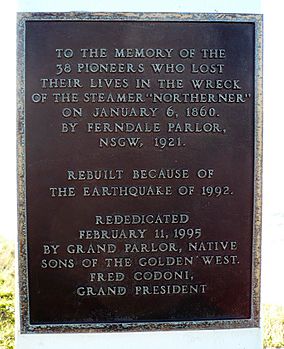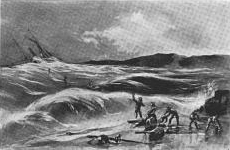Centerville Beach Cross facts for kids
Quick facts for kids Centerville Beach Cross |
|
|---|---|
 |
|
| Lua error in Module:Location_map at line 420: attempt to index field 'wikibase' (a nil value). | |
| Location | Humboldt County, California, United States |
| Nearest city | Eureka, California |
| Established | 1921 |
| Governing body | California Historical Landmarks |
| Reference #: | 173 |
The Centerville Beach Cross is a special monument. It remembers the 38 people who lost their lives when the ship SS Northerner sank. This sad event happened on January 6, 1860. The ship was owned by the Pacific Mail Steamship Company. It hit a hidden rock near Cape Mendocino. The Northerner then crashed onto Centerville Beach in Humboldt County, California. This monument is officially recognized as California Historical Landmark # 173.
What Happened to the SS Northerner?
The SS Northerner was a large paddle-wheel steamship. It was built in New York in 1847. For ten years, it carried mail and people along the coast.
The Ship's Last Voyage
On January 4, 1860, the Northerner left San Francisco. It was on its way to Victoria and Olympia. On January 5, the sea was calm, and a gentle south wind was blowing.
Hitting a Hidden Rock
Around 4 p.m., the ship was about four miles from Cape Mendocino. It passed between the cape and some rocks called Blunt's Reef. Suddenly, the ship felt a slight bump. People quickly checked the ship. They found that several wooden planks on the bottom were scraped off.
The Captain's Decision
The captain realized the ship was badly damaged. He knew it was sinking and could not be saved. He quickly decided to steer the ship towards the nearest land. Passengers and crew worked hard to bail water out of the ship. Meanwhile, the winds grew stronger, and huge waves crashed onto the beach.
The Shipwreck at Centerville Beach
The damaged ship finally reached the shore. It landed about 20 miles south of Humboldt Bay, near the small village of Centerville. The sea was very rough.
Trying to Reach Safety
The first small boat was launched from the ship. First officer Mr. A. French guided it. Four women and four children were in this boat. They all made it safely to the shore.
The next boat, however, was not so lucky. It flipped over in the waves. Two crew members drowned, but one woman from that boat was rescued. The third boat also capsized between the ship and the beach. Four more crew members were lost.
A Rope to Shore
The chief engineer and two firemen took another boat. They rowed to land and managed to set up a rope. This rope stretched from the shore to the wrecked ship. Many survivors used this rope to pull themselves to safety.
Mr. French, the first officer, bravely went back to the wreck. He wanted to save more people. But his boat got stuck under the ship in a strong current. Mr. French and three of his crew drowned.
The last boat carried Mr. O'Neill, the chief engineer, and another rope. Once he reached shore, a larger, stronger rope was pulled to land. Passengers tried to follow this line to safety. But the powerful waves were too strong. Many people were swept away, even those who tried to tie themselves to the rope. Others were hit by parts of the ship breaking apart in the waves.
Help from Centerville Residents
People living in Centerville quickly came to help. They cared for the injured survivors. The women were taken to the two buildings in the town.
The next morning, fourteen bodies were found on the sand. One woman passenger was found still tied to the ship's wheel. The rest of the bodies were lost to the ocean. All the bodies found were buried near the beach.
A Local Hero
A famous local man named Seth Kinman heard the ship's distress calls. Even in the terrible storm, Kinman tied himself to the shore. He waded into the crashing waves to save many passengers. Later, he was called a hero. He received a Bible and free travel for life on Pacific Mail Steamships.
Who Was Saved and Who Was Lost?
There were 108 people on board the Northerner at the start. Sadly, 38 people drowned. This included 17 passengers and 21 crew members.
However, many were saved! Thirty-eight passengers survived, including five of the six women and all four children. Thirty-two crew members also made it to safety.
The survivors stayed in Centerville for a day. Then, another ship, the Columbia, picked them up. This ship was also owned by the Pacific Mail Steamship Company. It took the survivors and 45 bags of mail north. The shipwreck also caused the loss of 13 bags of mail and $14,000 in government money.
Remembering the Northerner: The Monument
In 1921, a group called the Native Sons of the Golden West from Ferndale placed a cross and a marker on a hill. This hill overlooks Centerville Beach. This was the first monument to remember the Northerner shipwreck.
A New Marker for the Future
The first marker was unfortunately destroyed. This happened during the 1992 Cape Mendocino earthquakes. But people still wanted to remember the event. So, a new marker was put in its place. It was officially dedicated again on February 11, 1995.


